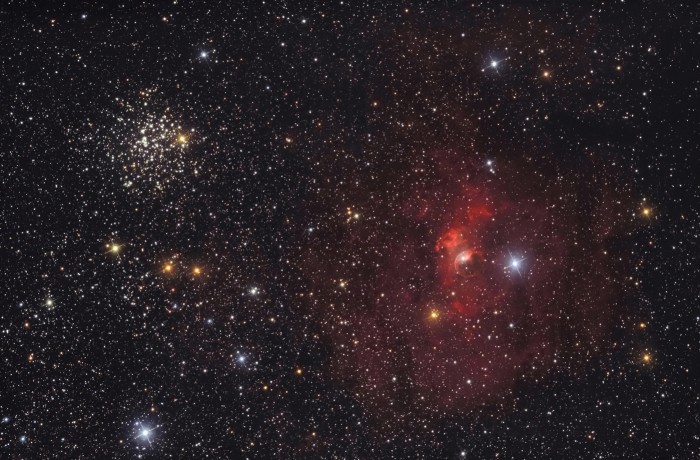The Cosmic Calendar
In this excerpt from the first episode of his TV series Cosmos, Carl Sagan imagines how the history of the universe would look if set against a regular Gregorian calendar:
We on Earth have just awakened to the great oceans of space and time from which we have emerged. We are the legacy of 15 billion years of cosmic evolution. We have a choice: We can enhance life and come to know the universe that made us, or we can squander our 15 billion-year heritage in meaningless self-destruction. What happens in the first second of the next cosmic year depends on what we do, here and now, with our intelligence and our knowledge of the cosmos.
– Carl Sagan
The Bubble and M52
From NASA APOD:
To the eye, this cosmic composition nicely balances the Bubble Nebula at the lower right with open star cluster M52. The pair would be lopsided on other scales, though. Embedded in a complex of interstellar dust and gas and blown by the winds from a single, massive O-type star, the Bubble Nebula, also known as NGC 7635, is a mere 10 light-years wide. On the other hand, M52 is a rich open cluster of around a thousand stars. The cluster is about 25 light-years across. Seen toward the northern boundary of Cassiopeia, distance estimates for the Bubble Nebula and associated cloud complex are around 11,000 light-years, while star cluster M52 lies nearly 5,000 light-years away. The wide telescopic field of view spans about 1.5 degrees on the sky or three times the apparent size of the Full Moon.
Telos
Apropos space exploration for survival:
“In modern Western society,” writes the scholar Charles Lindholm, “the erosion of tradition and the collapse of accepted religious belief leaves us without a telos [an end to which we strive], a sanctified notion of humanity’s potential. Bereft of a sacred project, we have only a demystified image of a frail and fallible humanity no longer capable of becoming god-like.”
I believe it is healthy—indeed, essential—to keep our frailty and fallibility firmly in mind. I worry about people who aspire to be “god-like.” But as for a long-term goal and a sacred project, there is one before us. On it the very survival of our species depends. If we have been locked and bolted into a prison of the self, here is an escape hatch—something worthy, something vastly larger than ourselves, a crucial act on behalf of humanity. Peopling other worlds unifies nations and ethnic groups, binds the generations, and requires us both to be smart and wise. It liberates our nature and, in part, returns us to our beginnings. Even now, this new telos is within our grasp.
– Carl Sagan
Great Orion Nebula
From NASA APOD:The Great Nebula in Orion, also known as M42, is one of the most famous nebulas in the sky. The star forming region’s glowing gas clouds and hot young stars are on the right in this sharp and colorful image that includes the smaller nebula M43 near center and dusty, bluish reflection nebulae NGC 1977 and friends on the left. Located at the edge of an otherwise invisible giant molecular cloud complex, these eye-catching nebulae represent only a small fraction of this galactic neighborhood’s wealth of interstellar material. Within the well-studied stellar nursery, astronomers have also identified what appear to be numerous infant planetary systems. The gorgeous skyscape spans nearly two degrees or about 45 light-years at the Orion Nebula’s estimated distance of 1,500 light-years.
The Quantum World
Another great Symphony of Science episode featuring Morgan Freeman, Stephen Hawking, Michio Kaku, Brian Cox, Richard Feynman, and Frank Close:
There is perhaps nothing as fascinating to consider as the disquieting fact that the two de facto models of everything we know—the entire Universe down the very smallest sub-atomic particles—are completely and utterly incompatible. What mind-blowing revelations might a unified model of physics bring?

